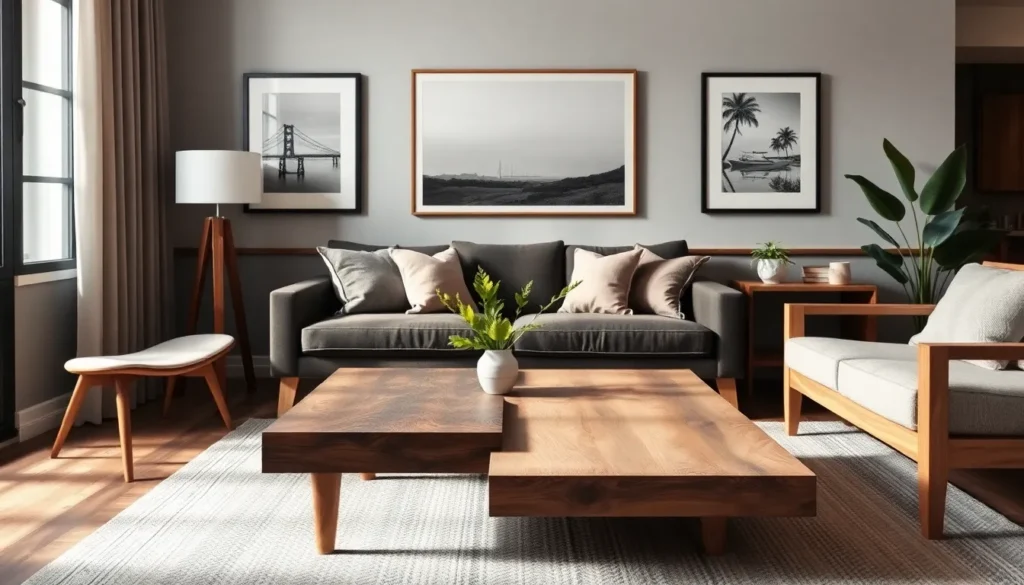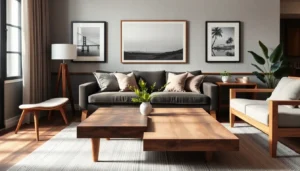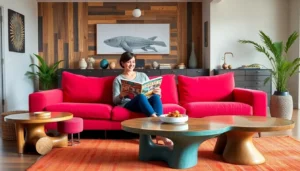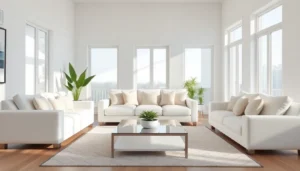Table of Contents
ToggleMixing dark and light wood furniture in a living room isn’t just a design choice; it’s a bold statement. Picture this: a cozy space that feels inviting yet sophisticated, where the rich tones of dark wood playfully dance with the airy vibes of light wood. It’s like your living room just threw a party, and all the best guests showed up!
But let’s be real—navigating the world of wood can feel like a game of chess. One wrong move and your room could end up looking like a lumberjack convention. Fear not! With a few clever tips and tricks, anyone can master the art of balancing these contrasting woods. Get ready to elevate your space and impress your guests with a living room that’s as stylish as it is welcoming.
Understanding the Aesthetic of Wood Furniture
Mixing dark and light wood furniture creates a dynamic aesthetic in the living room. The contrasting tones bring depth and visual interest to the space. Balance plays a crucial role; too much of one type can overwhelm the other. Aim for harmony between these wood types to enrich the overall design.
Textures influence appearance significantly. Dark woods, such as espresso or walnut, project sophistication, while light woods, like pine or oak, provide warmth. Combining rich and airy elements invites a cozy ambiance that appeals to many decorators.
When choosing furniture, consider the undertones of each wood. Warm undertones in light woods complement dark woods like mahogany, enhancing their color without clash. Neutral undertones work well across a broader range, allowing flexibility in design.
Proportion matters. Taller pieces of dark wood can ground a room, while lighter furnishings create an open feel. Varying furniture sizes helps establish a layered look, adding visual interest.
Accessories and decor tie everything together. Coordinating accent pieces, such as cushions or artwork, unifies the various wood tones. Incorporating a rug can also soften the transitions between the dark and light features, providing a cohesive flow.
Choosing appropriate lighting elevates the aesthetic. Warm-toned light bulbs can enhance wood colors, creating an inviting atmosphere. Natural light takes on a key role, highlighting the unique grains and patterns within each piece of furniture.
Through careful consideration and balancing of dark and light wood elements, a stylish and sophisticated living room emerges.
The Benefits of Mixing Dark and Light Wood
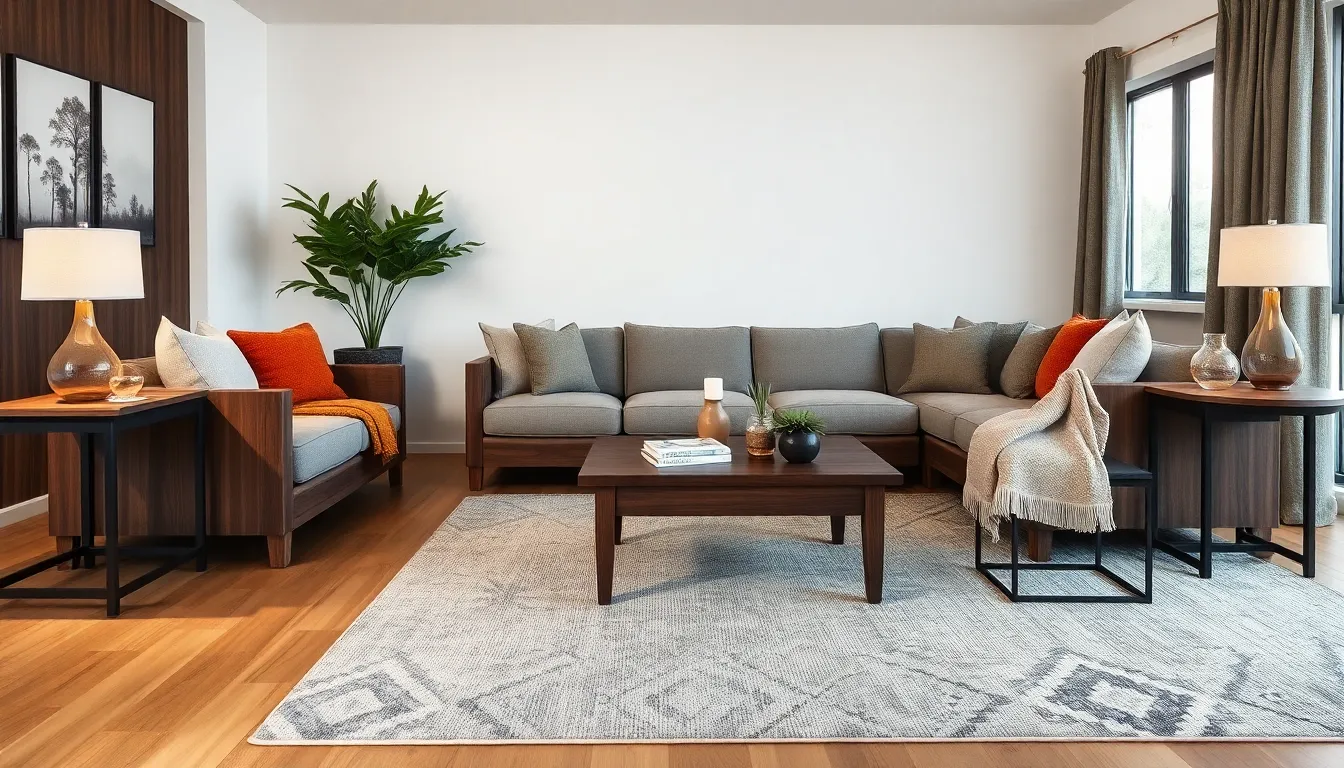
Mixing dark and light wood furniture offers significant advantages for living room design. This combination creates strong visual appeal and enhances the overall ambiance.
Creating Visual Contrast
Visual contrast plays a key role in interior design. Dark woods, like walnut, offer richness, while light woods, such as maple, provide a refreshing balance. This contrast draws the eye, making each piece of furniture stand out. Attention should focus on selecting complementary wood tones. The right hues can highlight the beauty of both dark and light pieces. Utilizing accessories in various finishes can bridge gaps between different wood styles, resulting in a cohesive look.
Adding Depth to Your Space
Depth significantly enhances spatial perception. Layering dark and light woods creates an illusion of dimension, which is especially beneficial in smaller rooms. Dark wood furniture can ground a space, instilling a sense of stability. Lighter pieces add an airy feel, preventing the room from becoming too heavy. Incorporating both textures introduces varied focal points around the room, enhancing visual interest. Accessories like cushions or throw blankets further enrich this layered effect, making the living area feel warm and inviting.
Tips for Mixing Dark and Light Wood Furniture
Successfully mixing dark and light wood furniture enhances the living room’s aesthetic appeal. Utilizing careful selection and balance leads to a harmonious design.
Choosing the Right Shades
Select wood shades that complement each other to avoid clashing. Heavier dark shades, like espresso or walnut, contrast with lighter woods such as maple or birch. Consider the undertones; warm light woods blend well with dark counterparts. Cool-toned woods may require careful matching to ensure visual harmony. Sample different shades together before finalizing choices, allowing for insight on overall cohesion. Observing natural light conditions in the room helps to determine how the colors interact throughout the day. Experimenting with different combinations creates opportunities for a unique design personal to the homeowner.
Balancing Proportions
Maintain visual balance through careful proportioning of dark and light woods. Taller dark furniture pieces, such as bookshelves, ground the room effectively. In contrast, lighter wood items, like coffee tables, introduce an airy feeling. Arrange pieces thoughtfully to create a cohesive look across the space. Mix and match larger pieces with smaller ones to avoid a top-heavy appearance. Use rugs and decorative accents to tie the various woods together visually. Ensure not to overcrowd the space with furniture. Doing so maintains an open atmosphere, allowing each wood’s distinct characteristics to shine.
Complementary Decor and Accessories
Choosing decor and accessories for a living room with mixed dark and light wood furniture enhances the overall aesthetic. Accents play an essential role; soft textiles like cushions, throws, and rugs help unify various wood tones. Prioritizing colors within these fabrics ensures harmony, particularly shades that reflect the warm undertones of light woods.
Wall art can also elevate the design. Selecting pieces with a mix of dark frames and light backgrounds creates balance that echoes the furniture. Lighting is crucial as well; fixtures with a combination of metal finishes can bridge the gap between dark and light woods, adding warmth and sophistication.
Using metallic accents, such as gold or brass, adds a touch of elegance. These materials complement both dark and light wood tones and enhance the overall look. Additionally, decorative items like vases and bookshelves can contribute to visual interest. Choosing shelves that feature both wood types helps create a cohesive look.
Plants also bring a vibrant element to the space. Incorporating greenery adds freshness, and choosing pots with neutral or complementary colors ties back to wood elements. Textured accessories, from woven basket storage to ceramic planters, create depth that softens contrasts.
Layering various textures across decor choices enriches the visual appeal. Fabrics, woods, and metals needn’t match exactly but should instead harmonize within the overall color palette. To achieve a sophisticated ambiance, thoughtful selection and arrangement of these elements ensure a well-balanced living room.
Mixing dark and light wood furniture can transform a living room into a stylish and inviting space. By balancing these contrasting elements, individuals can create a dynamic aesthetic that enhances visual interest. Thoughtful selection of wood tones and complementary decor ensures harmony throughout the room.
Incorporating textures and accessories further enriches the overall ambiance. Using soft textiles and strategic lighting can unify the various wood tones while adding warmth and sophistication. With careful attention to proportion and arrangement, anyone can achieve a cohesive look that impresses guests and provides a cozy atmosphere. Embracing this design approach allows for a personalized living area that reflects individual style and taste.

